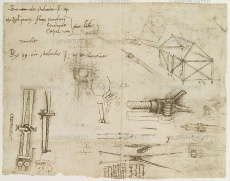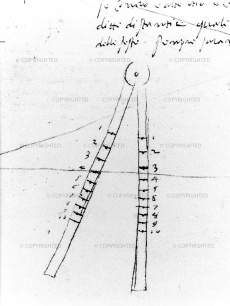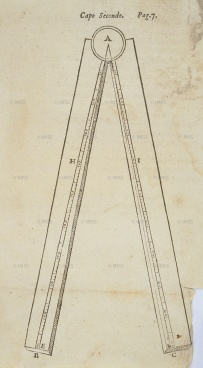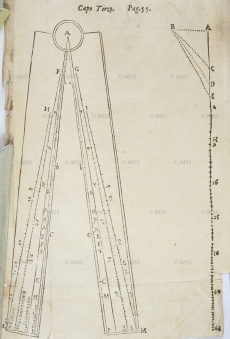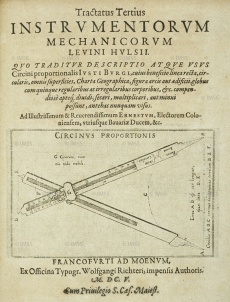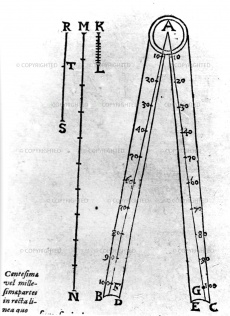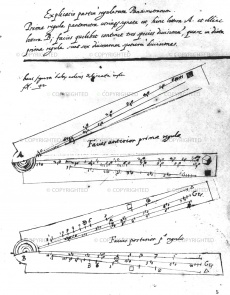Proportional Compasses
From Inventions
m (1 revision) |
|||
| (4 intermediate revisions not shown) | |||
| Line 1: | Line 1: | ||
{{Template invention | {{Template invention | ||
| - | |nome= | + | |nome= |
| + | Name used since the seventeenth century (in Latin "circini proportionalis"). | ||
| + | |||
|inventore= | |inventore= | ||
| - | |data= | + | |data= 15th-17th C. |
| - | |descrizione= | + | |descrizione= |
| + | Widely disseminated since the fifteenth century, the proportional compass is a computation instrument that operates by methodically exploiting the proportionality between the sides of similar triangles to solve arithmetical, geometric and trigonometric problems. The first important documentation on the instrument is provided by Leonardo da Vinci, who illustrates no less than three versions in the Codex Atlanticus: one with fixed pivot, one with mobile pivot ("Proportional compass viewed in profile. Proportional compass viewed from the front; and its pole is mobile. It is valid for irrational proportionalities") and one with fixed pivot and interchangeable points of different lengths depending on the desired proportions ("a b points are withdrawn or extended to greater or lesser length, depending on how much you want to diminish the object you are drawing. Proportional compasses made of rods and joints used like tongs"). The ''sesto de proporzionalità'' illustrated by Leonardo was a [[Four-Point Compasses | four-point compasses]] designed to draw proportional oval figures and a given circle, and to find "irrational proportionalities" ("On squaring the oval figure. After hearing that the circle has been squared, it is immediately possible to proceed to squaring the oval figure... with the rule for this motion you can make an oval figure, in whatever proportion you want, from a given circle, but you must do it with the proportional compasses, which are double, as can be seen in the margin"). Presumably however, the instrument was also used for calculating areas, volumes and square and cube roots, problems otherwise solved by Leonardo through geometric constructions used for tracing proportional scales that were widely disseminated in sixteenth-century treatises on arithmetic and geometry. Some of these constructions are found, in fact, among the notes of Antonio da Sangallo the Younger (c. 1530) explicitly dealing with the construction of a flat-legged proportional compass to "find any proportion whatsoever, of any kind it may be": a "compass made of iron or wood that follows a straight line and indicates the same measurements and proportions that are on the line". Later sixteenth-century variations of the proportional compass appeared, often bearing specific names: [["Compasso Magistrale" (Masterly Compasses) | "compasso magistrale" (masterly compasses)]], [["Compasso Roverino" (Compasses of Della Rovere) | "compasso roverino" (compasses of Della Rovere)]], [[Euclidean Compasses | Euclidean compasses]], [[Eight-Point Compasses | eight-point compasses]], [[Nine-Point Compasses | nine-point compasses]], [[Geometric and Military Compasses | geometric and military compasses]], [[pantometer]], [[polimeter]], or more generally "proportional compass". Starting from the versions of Guidobaldo del Monte and Galileo Galilei, the instrument definitively assumed the form of flat legs with proportional lines engraved on both sides. | ||
|componenti= | |componenti= | ||
| Line 32: | Line 35: | ||
| - | |strumentiesistenti= [http:// | + | |strumentiesistenti= |
| + | - Museo Galileo, Institute and Museum of the History of Science, Florence <br> | ||
| + | [http://catalogue.museogalileo.it/object/ProportionalCompasses.html Florence, Museo Galileo. Institute and Museum of the History of Science, Inv. 3683].<br /> | ||
[http://brunelleschi.imss.fi.it/museum/esim.asp?c=401092 Florence, Museo Galileo. Institute and Museum of the History of Science, Inv. 3685].<br /> | [http://brunelleschi.imss.fi.it/museum/esim.asp?c=401092 Florence, Museo Galileo. Institute and Museum of the History of Science, Inv. 3685].<br /> | ||
| - | [http:// | + | [http://catalogue.museogalileo.it/object/ProportionalCompasses_n01.html Florence, Museo Galileo. Institute and Museum of the History of Science, Inv. 650].<br /> |
| - | [http:// | + | [http://catalogue.museogalileo.it/object/ProportionalCompasses_n03.html Florence, Museo Galileo. Institute and Museum of the History of Science, Inv. 3647].<br /> |
| - | [http:// | + | [http://catalogue.museogalileo.it/object/ProportionalCompasses_n04.html Florence, Museo Galileo. Institute and Museum of the History of Science, Inv. 3676].<br /> |
| - | [http:// | + | [http://catalogue.museogalileo.it/object/ProportionalCompasses_n05.html Florence, Museo Galileo. Institute and Museum of the History of Science, Dep. GN, Roma].<br /> |
| + | |||
| + | |||
| + | - Musée des arts et métiers, Paris<br> | ||
| + | [http://cugnot.cnam.fr:8000/SEARCH/BASIS/COLLEC/INTERNET/objet/DDW?W%3DDESIG+PH+WORDS+%27compas+proportion%27+ORDER+BY+DESIG/Ascend%26M%3D5%26K%3D24218%26R%3DY%26U%3D1 Paris, Musée des arts et metiers, inv. 05128-0000-] <br /> | ||
| + | |||
| + | |||
| + | - Museum of the History of Science, Oxford <br> | ||
| + | [http://emu.mhs.ox.ac.uk/Display.php?irn=8365&QueryPage Museum of the History of Science, Oxford, inv. 28201]<br> | ||
| + | |||
| + | |||
|link= | |link= | ||
| + | http://www.unipd.it/vallisneri/strumenti/7.html (Italian)<br /> | ||
| + | http://www.palermoscienza.it/system/files/Il%20compasso%20geometrico%20militare.doc (Italian)<br /> | ||
| + | http://portail.atilf.fr/cgi-bin/getobject_?a.22:83:5./var/artfla/encyclopedie/textdata/IMAGE/ (French)<br /> | ||
| + | http://serge.savoysky.pagesperso-orange.fr/Compas%20de%20proportion,%20v3%20(WEB).pdf (French)<br /> | ||
| + | http://www.math.uqam.ca/_charbonneau/mat7222/WEBCT7222_04/textes/Ozanam_CompasPropp.pdf (French) | ||
|immagini= <gallery widths=230 heights=368 perrow=3> | |immagini= <gallery widths=230 heights=368 perrow=3> | ||
| Line 45: | Line 65: | ||
Image: 0101-39792.jpg | Leonardo da Vinci. ''Il Codice Atlantico di Leonardo da Vinci : edizione in facsimile dopo il restauro dell'originale conservato nella Biblioteca Ambrosiana di Milano''. Firenze, 1973-1975, c. 1046r.<br /> | Image: 0101-39792.jpg | Leonardo da Vinci. ''Il Codice Atlantico di Leonardo da Vinci : edizione in facsimile dopo il restauro dell'originale conservato nella Biblioteca Ambrosiana di Milano''. Firenze, 1973-1975, c. 1046r.<br /> | ||
| - | Image: 0050-40258.jpg | | + | Image: 0050-40258.jpg | Proportional compasses by Antonio da Sangallo the Younger, c.1530, Gabinetto dei Disegni e delle Stampe degli Uffizi, 1491A r.<br /> |
Image: 8855_3082_0152-069.jpg | Paolo Casati. ''Fabrica et vso del compasso di proportione : doue insegna à gli artefici il modo di fare in esso le necessarie diuisioni e con varij problemi vsuali mostra l'vtilità di questo stromento del molto rev. p. Paolo Casati ... dando le ragioni & apportando le dimostrationi di tutte le operationi nella fabrica e nell'vso : opera vtile non solo à geometri, agrimensori, architetti ciuili e militari, pittor''. Bologna, 1664, tav. p. 7.<br /> | Image: 8855_3082_0152-069.jpg | Paolo Casati. ''Fabrica et vso del compasso di proportione : doue insegna à gli artefici il modo di fare in esso le necessarie diuisioni e con varij problemi vsuali mostra l'vtilità di questo stromento del molto rev. p. Paolo Casati ... dando le ragioni & apportando le dimostrationi di tutte le operationi nella fabrica e nell'vso : opera vtile non solo à geometri, agrimensori, architetti ciuili e militari, pittor''. Bologna, 1664, tav. p. 7.<br /> | ||
Current revision as of 14:20, 7 September 2010
Name used since the seventeenth century (in Latin "circini proportionalis").
Contents |
Historic Period
15th-17th C.
Description
Widely disseminated since the fifteenth century, the proportional compass is a computation instrument that operates by methodically exploiting the proportionality between the sides of similar triangles to solve arithmetical, geometric and trigonometric problems. The first important documentation on the instrument is provided by Leonardo da Vinci, who illustrates no less than three versions in the Codex Atlanticus: one with fixed pivot, one with mobile pivot ("Proportional compass viewed in profile. Proportional compass viewed from the front; and its pole is mobile. It is valid for irrational proportionalities") and one with fixed pivot and interchangeable points of different lengths depending on the desired proportions ("a b points are withdrawn or extended to greater or lesser length, depending on how much you want to diminish the object you are drawing. Proportional compasses made of rods and joints used like tongs"). The sesto de proporzionalità illustrated by Leonardo was a four-point compasses designed to draw proportional oval figures and a given circle, and to find "irrational proportionalities" ("On squaring the oval figure. After hearing that the circle has been squared, it is immediately possible to proceed to squaring the oval figure... with the rule for this motion you can make an oval figure, in whatever proportion you want, from a given circle, but you must do it with the proportional compasses, which are double, as can be seen in the margin"). Presumably however, the instrument was also used for calculating areas, volumes and square and cube roots, problems otherwise solved by Leonardo through geometric constructions used for tracing proportional scales that were widely disseminated in sixteenth-century treatises on arithmetic and geometry. Some of these constructions are found, in fact, among the notes of Antonio da Sangallo the Younger (c. 1530) explicitly dealing with the construction of a flat-legged proportional compass to "find any proportion whatsoever, of any kind it may be": a "compass made of iron or wood that follows a straight line and indicates the same measurements and proportions that are on the line". Later sixteenth-century variations of the proportional compass appeared, often bearing specific names: "compasso magistrale" (masterly compasses), "compasso roverino" (compasses of Della Rovere), Euclidean compasses, eight-point compasses, nine-point compasses, geometric and military compasses, pantometer, polimeter, or more generally "proportional compass". Starting from the versions of Guidobaldo del Monte and Galileo Galilei, the instrument definitively assumed the form of flat legs with proportional lines engraved on both sides.
Bibliographical Resources
Antonio da Sangallo il Giovane. Gabinetto dei Disegni e delle Stampe degli Uffizi, 1491 A r-v; cfr. Frommel, Christoph L. e Adams, Nicholas, The Architectural Drawings of Antonio da Sangallo the Younger and His Circle, vol. I, Fortifications, Machines, and Festival Architecture, Cambridge (Mass.) e Londra, The MIT Press, 1994, pp. 246-247, 449.
Camerota, Filippo. Il Compasso di Fabrizio Mordente. Per la storia del compasso di proporzione, Firenze 2000.
Clavio, Cristoforo. Geometria Practica, Roma, 1604, lib. I, cap. I.
Favaro, Antonio. Per la storia del compasso di proporzione, in «Atti del Reale Istituto Veneto di Scienze, Lettere ed Arti», 67 (1907-08), pp. 723-739.
Gallucci, Giovanni Paolo. Della fabrica et uso di diversi strumenti di astronomia et cosmografia, ove si vede la somma della teorica et pratica di queste due nobilissime scienze, Venezia, Roberto Meietti, 1598, cap. XXI.
Leonardo da Vinci. Il Codice Atlantico della Biblioteca Ambrosiana di Milano, trascrizione diplomatica e critica di Augusto Marinoni, 12 voll., Firenze, Giunti-Barbèra, 1973-1980: foll. 157 rb = 425 v della nuova edizione; 248 ra = 672 r; 369 va = 1032 r; 375 ra = 1046 r.
Meskens, Ad. Michiel Coignet’s Contribution to the Development of the Sector, in «Annals of Science», 54 (1997), 2, pp. 143-160.
Rose, Paul Lawrence. The origins of proportional compass from Mordente to Galileo, in «Physis», X (1968), pp 53-69.
Schneider, Ivo. Der Proportionalzirchel. Ein universelles Analogrecheninstrument der Vergangenheit, München, R. Oldenburg Verlag, 1970.
Existing Instruments
- Museo Galileo, Institute and Museum of the History of Science, Florence
Florence, Museo Galileo. Institute and Museum of the History of Science, Inv. 3683.
Florence, Museo Galileo. Institute and Museum of the History of Science, Inv. 3685.
Florence, Museo Galileo. Institute and Museum of the History of Science, Inv. 650.
Florence, Museo Galileo. Institute and Museum of the History of Science, Inv. 3647.
Florence, Museo Galileo. Institute and Museum of the History of Science, Inv. 3676.
Florence, Museo Galileo. Institute and Museum of the History of Science, Dep. GN, Roma.
- Musée des arts et métiers, Paris
Paris, Musée des arts et metiers, inv. 05128-0000-
- Museum of the History of Science, Oxford
Museum of the History of Science, Oxford, inv. 28201
Links (External)
http://www.unipd.it/vallisneri/strumenti/7.html (Italian)
http://www.palermoscienza.it/system/files/Il%20compasso%20geometrico%20militare.doc (Italian)
http://portail.atilf.fr/cgi-bin/getobject_?a.22:83:5./var/artfla/encyclopedie/textdata/IMAGE/ (French)
http://serge.savoysky.pagesperso-orange.fr/Compas%20de%20proportion,%20v3%20(WEB).pdf (French)
http://www.math.uqam.ca/_charbonneau/mat7222/WEBCT7222_04/textes/Ozanam_CompasPropp.pdf (French)
Images
Paolo Casati. Fabrica et vso del compasso di proportione : doue insegna à gli artefici il modo di fare in esso le necessarie diuisioni e con varij problemi vsuali mostra l'vtilità di questo stromento del molto rev. p. Paolo Casati ... dando le ragioni & apportando le dimostrationi di tutte le operationi nella fabrica e nell'vso : opera vtile non solo à geometri, agrimensori, architetti ciuili e militari, pittor. Bologna, 1664, tav. p. 7. |
||
Paolo Casati. Fabrica et vso del compasso di proportione : doue insegna à gli artefici il modo di fare in esso le necessarie diuisioni e con varij problemi vsuali mostra l'vtilità di questo stromento del molto rev. p. Paolo Casati ... dando le ragioni & apportando le dimostrationi di tutte le operationi nella fabrica e nell'vso : opera vtile non solo à geometri, agrimensori, architetti ciuili e militari, pittor. Bologna, 1664, tav. p. 55. |
||
Author of the entry: Filippo Camerota
